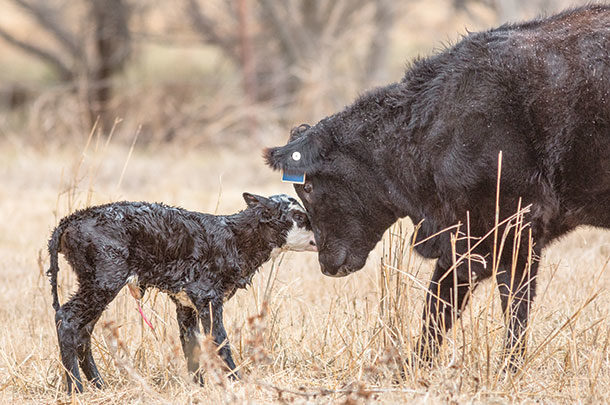Preparing for the breeding season is a year-round project with many steps along the way to ensure high reproductive success in a herd.
Selecting for fertility can be broken down into two concepts: selection in replacement females and herd sires, and inherent selection through management. Fertility selection is challenging because management and environment can sometimes get in the way of success.
Breeding season toolbox
Genetics can play a role in fertility selection but, as we have learned over the past 60 years, reproductive traits are lowly heritable – approximately 10 percent for pregnancy rates – because management and environment can have a significant impact on the outcome. This is not to discourage anyone from using fertility traits in selecting replacement heifers or herd sires. However, purchasing some of the best genetics doesn’t guarantee you will get the best outcome; your management has to work, and your environment has to cooperate.
When we look at some of the available genetic traits that could influence fertility, we need to be cognizant of their heritability, or the phenotypic variation in a trait due to individual genetics. We can break heritability down into three classifications: low (less than 0.20), moderate (between 0.20 and 0.50) and high (greater than 0.50).
Over the years, many studies have estimated the heritability of certain traits and, because of this, there are typically multiple heritability estimates for each trait due to conditions in the management and environment of the study, which creates a range. Based on a review of past research, most of the genetic traits affecting fertility fall into the low-heritability classification.
Low-heritability traits include calving date, calving interval, calving-to-conception interval, first-service conception, heifer pregnancy and stayability.
Traits that fall into the moderate-heritability classification include bodyweight at first estrus, dystocia, the correlation between scrotal circumference and age at first calving, pregnancy rate and calving interval.
Traits that fall into the high-heritability classification include scrotal circumference and age at puberty.
Breed associations have several of these traits expressed as expected progeny differences (EPDs) that have been developed to use as selection tools for improving fertility. However, we can’t forget management and environment can have a greater influence than genetics.
Replacement heifers
The goal in every herd should be to have heifers reach puberty before the breeding season. Puberty is controlled by three factors: bodyweight, age and breed.
With age and breed, we know Bos taurus cattle (e.g., Angus, Hereford, Shorthorn) reach puberty between 12 and 14 months old, whereas Bos indicus cattle (e.g., Brahman, Braford, Beefmaster) reach puberty later (approximately 16 to 18 months old). Regarding bodyweight, heifers should reach 65 percent of their expected mature bodyweight at breeding.
These three factors combined increase the likelihood of a replacement heifer reaching puberty. Because of genetic selection and changes in nutritional development over time, we have seen a decrease in age at puberty.
Bull selection
Selection for scrotal circumference in bulls is one of the few highly heritable reproductive traits used. For every 1-centimeter increase in scrotal circumference, a bull’s daughter is expected to reach puberty four days earlier. Research out of Canada has shown scrotal circumference increased by 0.5 to 3.5 centimeters in seven Bos taurus breeds of bulls from 1972 to 2011. This had a positive impact on reducing the age at puberty in replacement heifers and is a trait everyone should use during selection.
Crossbreeding
Management can inherently impact fertility. The use of crossbreeding has been a proven management tool to express breed complementarity through hybrid vigor. Improved animal performance through genetic efficiency is often a result of hybrid vigor when compared with straight breeding.
Growth performance and fertility traits have improved through crossbreeding. Positive fertility traits related to crossbreeding include reaching puberty earlier, increased pregnancy and weaning rates, decreased dystocia, increased longevity and decreased calving interval.
Body condition score
Calving at optimal body condition can have one of the biggest impacts on fertility during the subsequent breeding season. Using body condition score (BCS) at calving is one of the best tools to use, as it provides a forecast of a cow’s probability of conceiving early on in the breeding season.
As mentioned earlier, managing for high fertility happens all year long. If cows calve in a low body condition, their nutrient requirements increase significantly to make up for the loss in body condition. We know the fetus gains approximately 67 percent of its weight in the last three months of pregnancy. Condition scoring your cows before the last three months of pregnancy will allow you to make diet adjustments early on and ensure your cows are calving at a BCS of 5 or better.
Pregnancy rates
Last, you may have often heard you can genetically select for pregnancy rates, but now you know this trait is lowly heritable. Instead, if you tightly manage your breeding and calving seasons, and maintain strict culling criteria, you are indirectly selecting for fertility. You can see the biggest improvement when starting with replacement heifers. If you manage your heifers and keep only those that conceive within the first 30 days of the breeding season, you are selecting for females that should be more fertile.
Research out of the U.S. Meat Animal Research Center in Clay Center, Nebraska, and preliminary data out of Louisiana State University showed at least 20 percent of heifers calving in the first 20 to 30 days of their first calving season remained in the herd through their fifth calf.
Using genetic traits to select for fertility in replacement females and herd sires is a great starting point. This allows you to start with the best set of replacement females genetically selected for the traits you focus on. Managing your herd to calve a high percentage within the first 30 days will result in a positive correlation with other important fertility traits.
Following up with proper management, such as crossbreeding, BCS and a tighter calving season, under the right environmental conditions will allow you to naturally select for improved fertility. ![]()
PHOTO: Condition scoring your cows before the last three months of pregnancy will allow you to make diet adjustments early on and ensure your cows are calving at a BCS of 5 or better. Photo courtesy of Noble Research Institute.

-
Ryon Walker
- Livestock Consultant
- Noble Research Institute
- Email Ryon Walker












